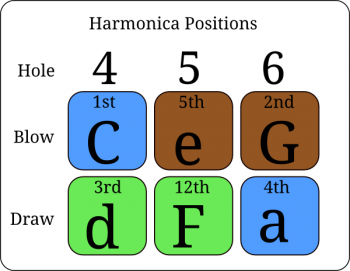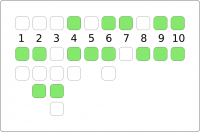"Pick any unbent note from holes 4, 5 or 6 - blow or draw. Play that note's pentatonic scale either upwards or downwards or in both directions."
If you haven't already read how to play six keys on a diatonic harmonica without overblows using Pentatonic scales I recommend you do so now. Get familiar with the three different breath patterns. It's common to get familiar with first, second and third positions.
Now, take a look at the middle octave of your harp. The six unbent notes played on holes 4, 5 and 6 are the tonic notes for each of the six scales you can play easily. Here's a chart to help you remember what key, breath pattern and position each scale represents when starting the scale from the middle octave.

Positions are indicated by number. Notes with matching colours have related scales. Capital letters are major scales, lowercase are minor.
Four blow and Six draw breath pattern:

First and Fourth position breath pattern
The C scale on a C harp is first position. The C scale has a relative minor - A minor. They both share the same notes - they just have a different tonic (the note you start and end on). Therefore, they share the same breath patterns on the diatonic harmonica. Once you have mastered the major pentatonic scale in first position, play the A minor scale which starts and ends on the draw 6 and that's fourth position.
Starting on the 6 draw, go upwards as well as downwards. Concentrate on resolving on the 6 draw. Go crazy and add vibrato to the 6 draw - if you have mostly played second position you may find resolving on and adding vibrato to the 6 draw feels funny at first. But try to make that note soulful; land on it with purpose and you will begin to master playing in fourth position.
Five blow and Six blow breath pattern:

Second and Fifth position breath pattern
The G major scale is second position on a C harp and its relative minor is E minor. E minor starts and ends on the 5 blow and that's fifth position - again same breath pattern as second position, just a different tonic. As with fourth position, it will feel funny to add vibrato to the 5 blow. But once you become comfortable with making that note stand out as the tonic, you will be on your way to mastering fifth position.
Four draw and Five draw breath pattern:

Third and twelfth position breath pattern
Third position is a minor scale starting on the 4 draw. Its relative major is F major - 5 draw and that's 12th position. I find the 5 draw can have a surprising amount of soul or "sass" if you carefully lean into it. We are used to wailing on the 2 draw or 4 draw and bending those notes as we bear down into them. The 5 draw can't be bent any more than a quarter step, but it can nonetheless be a very powerful wailing note.
Here's how this chart is a really useful learning tool: Pick any unbent note from holes 4, 5 or 6 - blow or draw. Play that note's pentatonic scale either upwards or downwards or in both directions. Pick another note and do the same. Try to cycle randomly through all six notes until you have gone trough all of them. Although you only have to master three breath patterns to play all those scales, the hard part is knowing where to start and stop the scale. Without a beginning or an end, it's one meaningless string of notes.
Once you "burn" this chart into your memory, playing these scales is a snap. Part of the advantage of starting in the middle of the harp is that you have the option to change things up and play the scale downwards instead of always starting scales going up (ascending). And that brings you closer to being able to use these scales as more than an exercise but as a music-making tool.
You will probably find that after a little while, you can resolve to the tonic note in the other octaves too without having to think about it. That's because you have learned the breath patterns and you have zeroed-in on how to get these scales to sound the way you think they should. Scales have a learning curve but once you get through it. their job is to make things easier for you.
The other advantage of this middle-octave stuff is that you can think in terms of positions, rather than key. This is helpful if you play a different key harp than C. You will now be able to figure out which key corresponds to which position on any key harp by naming the unbent notes of holes 4, 5 and 6. All you need to do is be able to name the notes of the major scale of that harp's key and start counting on the 4 blow!




